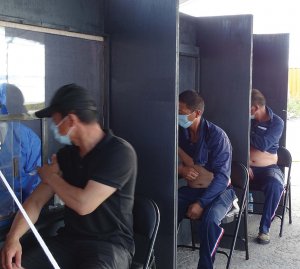In a world reeling from the spread of the COVID-19 delta variant, one of the strictest quarantine border controls has kept the Marshall Islands COVID-free.
A four-week managed quarantine — two weeks in Honolulu and two in the Marshall Islands — is required for any inbound traveler. Only one case, in July 2020, was picked up in managed quarantine at Kwajalein, a returning U.S. Army missile range worker. Since then, all positive cases have been identified in Hawaii, reducing the potential for spread back home.
As of 27 August, more than 90 percent of adults in the two urban centers of Majuro and Ebeye were fully or partially vaccinated using either Moderna or Johnson & Johnson vaccines. The percentage of vaccinated adults on outer islands continued to increase as teams of public health nurses spread the vaccine throughout the country. For the first time, the Ministry of Health began bringing in Pfizer vaccines at the end of August to launch vaccines of 12 to 17 years old residents.
Within its strict protocols for entry, the Marshall Islands found a way to both revive its tuna transshipment industry that pre-COVID saw Majuro as the busiest transshipment port in the world. In May it eased port entry provisions for vessels, dropping a 14-day quarantine provision and in June launched the Pacific’s first COVID vaccine program for commercial fishermen.
In a remarkable rebound, the tuna transshipment business in Majuro hit its pre-COVID monthly average the first three months that port entry requirements were eased beginning in May. After a 60 percent decline in 2020, the 112 transshipments from May through July were at an average of 37 per month, which matched the pre-COVID transshipment monthly average when more than 400 transshipments occurred annually in Majuro. The 156 transshipments in the first six months of 2021 nearly matched the 175 for all of 2020.
The Ministry of Health administered 312 vaccines for the commercial fishing crews that use Majuro for transshipment in June before halting the programme to focus on vaccinating outer island residents. The Marshall Islands Marine Resources Authority coordinated with the Ministry of Health and other agencies to resume dockside vaccinations of fishermen in August, both to protect the crews and as a draw to bring more transshipment activity to Majuro.
The last two Fridays of August resulted in nine purse seine vessels bringing 299 crew members to receive the one-dose Johnson & Johnson vaccine. Authorities set up a secure area at one end of the main commercial dock, with stations for fishermen to wait for their shots, to receive their shots, and to wait for a 10-minute observation period afterward prior to being allowed to return to their vessels. Three public health nurses provided the immunisations from behind plexiglass dividers that had a small sliding window big enough for the person to place their arm next to it to receive the shot.
Fisheries Director Glen Joseph said with high demand for the vaccine programme from fishing vessels, the programme is expected to continue every Friday for the foreseeable future.
On the domestic front, the Ministry of Health has built new facilities and obtained equipment to be ready for an outbreak of COVID.
Prior to the pandemic, Majuro hospital had two ventilators. Now it has 34. Ebeye hospital had a similar number pre-COVID and now has 10, with four additional being repaired, said Health Secretary Jack Niedenthal. Numerous partners, including the United States and Taiwan have helped by providing funding and equipment to improve the country’s Covid preparedness.
In terms of isolation facilities, “Eight people can be accommodated in new ICU, in a surge situation, seven more in the TB (unit), and (if it was) really bad we can use the new surgical ward with 29 beds,” Niedenthal said of Majuro’s COVID preparedness.
On Ebeye, six people can be accommodated during a surge situation in a newly built ICU, with four more in a TB unit.
A quarantine facility in Majuro outside of the hospital can accommodate seven in a high-risk situation, 12 for low risk.
SOURCE: MARIANAS BUSINESS JOURNAL/PACNEWS














